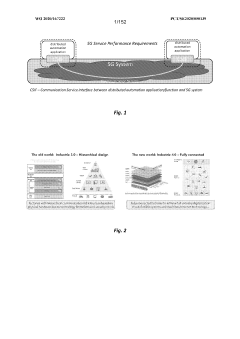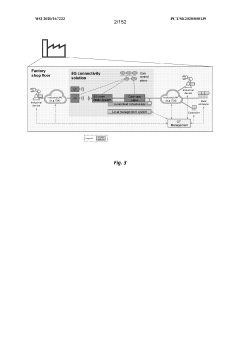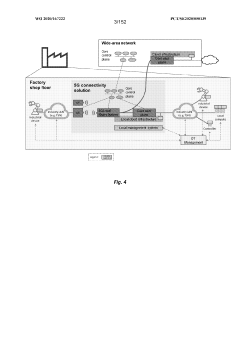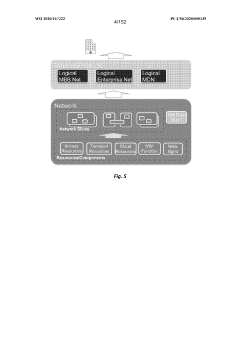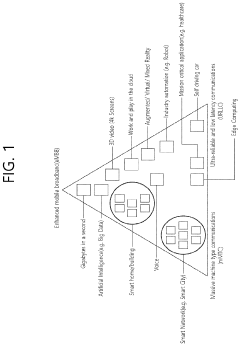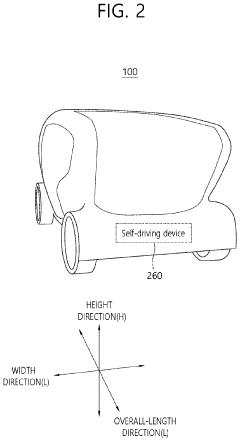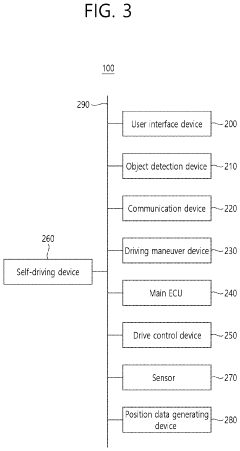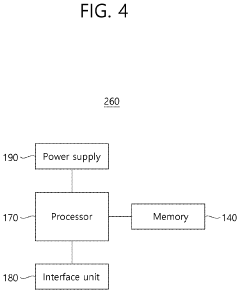What are the Challenges of 5G UC in Mountainous Region Connectivity?
JUL 18, 20259 MIN READ
Generate Your Research Report Instantly with AI Agent
Patsnap Eureka helps you evaluate technical feasibility & market potential.
5G UC Mountain Challenges
The deployment of 5G Ultra-Capacity (UC) networks in mountainous regions presents a unique set of challenges that require innovative solutions. The rugged terrain and sparse population distribution in these areas create significant obstacles for network operators and equipment manufacturers.
One of the primary challenges is signal propagation. The steep slopes, deep valleys, and dense vegetation characteristic of mountainous regions can severely impede the transmission of high-frequency 5G signals. This results in reduced coverage areas and potential dead zones, making it difficult to provide consistent connectivity across the landscape.
Infrastructure deployment poses another major hurdle. The lack of accessible roads and suitable sites for base stations complicates the installation and maintenance of 5G equipment. Traditional tower-based solutions may not be feasible in many locations, necessitating alternative approaches such as small cells or satellite-based systems.
Power supply is a critical concern in remote mountainous areas. Many locations lack reliable access to the electrical grid, requiring the implementation of off-grid power solutions. This may involve the use of solar panels, wind turbines, or fuel cells, adding complexity and cost to network deployment.
The harsh environmental conditions prevalent in mountainous regions also present challenges. Equipment must be designed to withstand extreme temperatures, high humidity, strong winds, and heavy snowfall. This requires robust engineering and specialized materials, potentially increasing the overall cost of network infrastructure.
Backhaul connectivity is another significant challenge. The limited availability of fiber optic networks in remote areas necessitates the use of alternative backhaul solutions, such as microwave links or satellite connections. These options may have limitations in terms of capacity and latency, potentially impacting the performance of 5G UC services.
The economic viability of 5G UC deployment in mountainous regions is a major consideration. The high costs associated with overcoming the aforementioned challenges, coupled with the typically low population density, can make it difficult for operators to justify the investment. This may lead to a digital divide between urban and rural mountainous areas.
Addressing these challenges requires a multifaceted approach, combining technological innovation, policy support, and creative business models. Collaborative efforts between network operators, equipment manufacturers, and local authorities will be crucial in developing effective solutions for 5G UC connectivity in mountainous regions.
One of the primary challenges is signal propagation. The steep slopes, deep valleys, and dense vegetation characteristic of mountainous regions can severely impede the transmission of high-frequency 5G signals. This results in reduced coverage areas and potential dead zones, making it difficult to provide consistent connectivity across the landscape.
Infrastructure deployment poses another major hurdle. The lack of accessible roads and suitable sites for base stations complicates the installation and maintenance of 5G equipment. Traditional tower-based solutions may not be feasible in many locations, necessitating alternative approaches such as small cells or satellite-based systems.
Power supply is a critical concern in remote mountainous areas. Many locations lack reliable access to the electrical grid, requiring the implementation of off-grid power solutions. This may involve the use of solar panels, wind turbines, or fuel cells, adding complexity and cost to network deployment.
The harsh environmental conditions prevalent in mountainous regions also present challenges. Equipment must be designed to withstand extreme temperatures, high humidity, strong winds, and heavy snowfall. This requires robust engineering and specialized materials, potentially increasing the overall cost of network infrastructure.
Backhaul connectivity is another significant challenge. The limited availability of fiber optic networks in remote areas necessitates the use of alternative backhaul solutions, such as microwave links or satellite connections. These options may have limitations in terms of capacity and latency, potentially impacting the performance of 5G UC services.
The economic viability of 5G UC deployment in mountainous regions is a major consideration. The high costs associated with overcoming the aforementioned challenges, coupled with the typically low population density, can make it difficult for operators to justify the investment. This may lead to a digital divide between urban and rural mountainous areas.
Addressing these challenges requires a multifaceted approach, combining technological innovation, policy support, and creative business models. Collaborative efforts between network operators, equipment manufacturers, and local authorities will be crucial in developing effective solutions for 5G UC connectivity in mountainous regions.
Market Demand Analysis
The market demand for 5G UC (Ultra-Reliable Low-Latency Communication) in mountainous regions is driven by the increasing need for robust connectivity in challenging terrains. These areas, characterized by rugged landscapes and sparse populations, have traditionally been underserved by telecommunications infrastructure. However, the growing importance of digital inclusion and the potential for economic development in these regions have created a significant market opportunity for 5G UC solutions.
In mountainous areas, industries such as mining, forestry, and tourism require reliable high-speed connectivity to optimize operations and enhance safety measures. The mining sector, in particular, stands to benefit greatly from 5G UC, as it enables real-time monitoring of equipment, remote operation of machinery, and improved worker safety through advanced communication systems. This sector alone represents a substantial market for 5G UC technologies tailored to mountainous environments.
Tourism in mountainous regions is another key driver of market demand. As visitors increasingly expect seamless connectivity even in remote locations, the hospitality industry is pressured to provide high-quality internet services. This demand extends to emergency services and search and rescue operations, where reliable communication can be life-saving in challenging terrains.
The agriculture sector in mountainous areas is also showing interest in 5G UC technologies. Precision farming techniques, which rely on real-time data transmission from sensors and drones, can significantly benefit from the low latency and high reliability of 5G networks. This application has the potential to transform agricultural practices in traditionally difficult-to-farm mountainous regions.
Government initiatives aimed at bridging the digital divide are further fueling the market demand for 5G UC in mountainous regions. Many countries are implementing policies and allocating funds to extend high-speed internet coverage to rural and remote areas, recognizing its importance for economic development and social equity.
The market size for 5G UC in mountainous regions is expected to grow significantly in the coming years. While specific figures for mountainous areas are not readily available, the overall 5G market in rural and remote areas is projected to expand rapidly. This growth is driven by the increasing recognition of connectivity as a fundamental infrastructure requirement, similar to roads and electricity.
However, the market demand is tempered by the unique challenges posed by mountainous terrains. The high cost of infrastructure deployment in these areas and the technical difficulties in maintaining reliable signals across varied topography are significant factors that influence market dynamics. These challenges create opportunities for innovative solutions that can effectively address the specific needs of mountainous regions while remaining cost-effective.
In mountainous areas, industries such as mining, forestry, and tourism require reliable high-speed connectivity to optimize operations and enhance safety measures. The mining sector, in particular, stands to benefit greatly from 5G UC, as it enables real-time monitoring of equipment, remote operation of machinery, and improved worker safety through advanced communication systems. This sector alone represents a substantial market for 5G UC technologies tailored to mountainous environments.
Tourism in mountainous regions is another key driver of market demand. As visitors increasingly expect seamless connectivity even in remote locations, the hospitality industry is pressured to provide high-quality internet services. This demand extends to emergency services and search and rescue operations, where reliable communication can be life-saving in challenging terrains.
The agriculture sector in mountainous areas is also showing interest in 5G UC technologies. Precision farming techniques, which rely on real-time data transmission from sensors and drones, can significantly benefit from the low latency and high reliability of 5G networks. This application has the potential to transform agricultural practices in traditionally difficult-to-farm mountainous regions.
Government initiatives aimed at bridging the digital divide are further fueling the market demand for 5G UC in mountainous regions. Many countries are implementing policies and allocating funds to extend high-speed internet coverage to rural and remote areas, recognizing its importance for economic development and social equity.
The market size for 5G UC in mountainous regions is expected to grow significantly in the coming years. While specific figures for mountainous areas are not readily available, the overall 5G market in rural and remote areas is projected to expand rapidly. This growth is driven by the increasing recognition of connectivity as a fundamental infrastructure requirement, similar to roads and electricity.
However, the market demand is tempered by the unique challenges posed by mountainous terrains. The high cost of infrastructure deployment in these areas and the technical difficulties in maintaining reliable signals across varied topography are significant factors that influence market dynamics. These challenges create opportunities for innovative solutions that can effectively address the specific needs of mountainous regions while remaining cost-effective.
Technical Hurdles
The implementation of 5G UC (Ultra-Reliable Low-Latency Communication) in mountainous regions faces several significant technical hurdles. The primary challenge stems from the complex topography, which creates obstacles for signal propagation and network coverage. The rugged terrain, steep slopes, and dense vegetation characteristic of mountainous areas lead to severe signal attenuation and multipath fading, making it difficult to maintain consistent and reliable connectivity.
One of the key technical issues is the limited line-of-sight (LOS) between base stations and user equipment. The presence of mountains and valleys creates numerous dead zones where signals cannot penetrate, resulting in coverage gaps. This problem is exacerbated by the need for higher frequency bands in 5G, which have shorter wavelengths and are more susceptible to obstruction by physical barriers.
Another significant challenge is the increased path loss experienced in mountainous environments. The irregular terrain causes signals to undergo multiple reflections, diffractions, and scattering, leading to substantial signal degradation. This not only affects the signal strength but also introduces latency and jitter, which are critical factors in achieving the ultra-reliable and low-latency requirements of 5G UC applications.
The deployment of network infrastructure in mountainous regions presents its own set of difficulties. The harsh terrain makes it challenging to install and maintain base stations, fiber optic cables, and other necessary equipment. Access to power sources can be limited, requiring innovative solutions for energy supply and management. Additionally, the cost of infrastructure deployment in these areas is significantly higher compared to urban or flat rural regions.
Weather conditions in mountainous areas pose another technical hurdle. Extreme temperatures, heavy rainfall, snow, and ice can affect the performance and reliability of 5G equipment. These conditions can lead to signal fluctuations, equipment failures, and increased maintenance requirements, further complicating the task of ensuring consistent 5G UC connectivity.
The dynamic nature of mountainous environments also presents challenges for network planning and optimization. Seasonal changes in vegetation, varying atmospheric conditions, and even the movement of large objects like vehicles in narrow mountain passes can significantly impact signal propagation. This requires adaptive and flexible network solutions that can adjust to changing environmental conditions.
Lastly, the sparse population distribution typical in mountainous regions creates economic challenges for network operators. The high cost of infrastructure deployment and maintenance, coupled with potentially low user density, makes it difficult to justify the investment in comprehensive 5G UC coverage. This economic factor often results in a technological divide, where mountainous areas lag behind in the adoption of advanced communication technologies.
One of the key technical issues is the limited line-of-sight (LOS) between base stations and user equipment. The presence of mountains and valleys creates numerous dead zones where signals cannot penetrate, resulting in coverage gaps. This problem is exacerbated by the need for higher frequency bands in 5G, which have shorter wavelengths and are more susceptible to obstruction by physical barriers.
Another significant challenge is the increased path loss experienced in mountainous environments. The irregular terrain causes signals to undergo multiple reflections, diffractions, and scattering, leading to substantial signal degradation. This not only affects the signal strength but also introduces latency and jitter, which are critical factors in achieving the ultra-reliable and low-latency requirements of 5G UC applications.
The deployment of network infrastructure in mountainous regions presents its own set of difficulties. The harsh terrain makes it challenging to install and maintain base stations, fiber optic cables, and other necessary equipment. Access to power sources can be limited, requiring innovative solutions for energy supply and management. Additionally, the cost of infrastructure deployment in these areas is significantly higher compared to urban or flat rural regions.
Weather conditions in mountainous areas pose another technical hurdle. Extreme temperatures, heavy rainfall, snow, and ice can affect the performance and reliability of 5G equipment. These conditions can lead to signal fluctuations, equipment failures, and increased maintenance requirements, further complicating the task of ensuring consistent 5G UC connectivity.
The dynamic nature of mountainous environments also presents challenges for network planning and optimization. Seasonal changes in vegetation, varying atmospheric conditions, and even the movement of large objects like vehicles in narrow mountain passes can significantly impact signal propagation. This requires adaptive and flexible network solutions that can adjust to changing environmental conditions.
Lastly, the sparse population distribution typical in mountainous regions creates economic challenges for network operators. The high cost of infrastructure deployment and maintenance, coupled with potentially low user density, makes it difficult to justify the investment in comprehensive 5G UC coverage. This economic factor often results in a technological divide, where mountainous areas lag behind in the adoption of advanced communication technologies.
Current 5G UC Solutions
01 Network architecture for URLLC in 5G
Specialized network architectures are designed to support Ultra-Reliable and Low-Latency Communication (URLLC) in 5G networks. These architectures focus on optimizing resource allocation, reducing packet transmission delays, and enhancing reliability through techniques such as network slicing and edge computing.- Network architecture for URLLC in 5G: Specialized network architectures are designed to support Ultra-Reliable and Low-Latency Communication (URLLC) in 5G networks. These architectures focus on optimizing resource allocation, reducing packet transmission delays, and enhancing reliability through techniques such as network slicing and edge computing.
- Radio resource management for URLLC: Advanced radio resource management techniques are employed to meet the stringent requirements of URLLC. These include dynamic scheduling algorithms, flexible frame structures, and adaptive transmission schemes that prioritize low-latency and high-reliability traffic.
- URLLC for industrial applications: 5G URLLC is tailored for industrial use cases, enabling real-time control, automation, and monitoring in smart factories and Industry 4.0 environments. This involves developing specialized protocols and interfaces to support time-critical industrial applications.
- Multi-connectivity solutions for URLLC: Multi-connectivity techniques are implemented to enhance the reliability and reduce latency in 5G URLLC. These solutions involve simultaneous connections to multiple base stations or radio access technologies, ensuring seamless and robust communication.
- AI and machine learning for URLLC optimization: Artificial intelligence and machine learning algorithms are utilized to optimize URLLC performance in 5G networks. These technologies enable predictive resource allocation, intelligent network slicing, and adaptive QoS management to meet the demanding requirements of ultra-reliable and low-latency applications.
02 Radio resource management for URLLC
Advanced radio resource management techniques are employed to meet the stringent requirements of URLLC. These include dynamic scheduling algorithms, flexible frame structures, and adaptive transmission schemes that prioritize low-latency and high-reliability traffic.Expand Specific Solutions03 URLLC protocol enhancements
Protocol enhancements specific to URLLC are developed to improve performance. These include modifications to the physical layer, MAC layer, and higher layers to reduce processing times, minimize retransmissions, and ensure reliable data delivery within strict time constraints.Expand Specific Solutions04 Multi-connectivity solutions for URLLC
Multi-connectivity solutions are implemented to enhance reliability and reduce latency in URLLC scenarios. These solutions involve simultaneous connections to multiple base stations or radio access technologies, enabling seamless handovers and improved link robustness.Expand Specific Solutions05 AI and machine learning for URLLC optimization
Artificial intelligence and machine learning techniques are applied to optimize URLLC performance in 5G networks. These approaches enable predictive resource allocation, intelligent traffic steering, and adaptive network configuration to meet the demanding requirements of ultra-reliable and low-latency applications.Expand Specific Solutions
Key Industry Players
The 5G UC connectivity in mountainous regions faces significant challenges, with the market in a nascent stage of development. The technology's maturity is still evolving, as major players like Huawei, Samsung, and Ericsson work to overcome obstacles related to signal propagation and infrastructure deployment in rugged terrains. While the potential market size is substantial, given the need for improved connectivity in remote areas, the current scale remains limited. Companies such as China Telecom and AT&T are exploring innovative solutions, but the complex topography and high implementation costs pose considerable hurdles. As the industry progresses, collaboration between telecom giants, equipment manufacturers, and research institutions like Chongqing University of Posts & Telecommunications will be crucial in addressing these challenges and expanding 5G UC coverage in mountainous regions.
Huawei Technologies Co., Ltd.
Technical Solution: Huawei has developed a comprehensive solution for 5G UC in mountainous regions, focusing on overcoming signal propagation challenges. Their approach includes advanced beamforming techniques and intelligent network planning. Huawei's RuralStar Pro solution, specifically designed for remote areas, utilizes innovative relay technology to extend 5G coverage in challenging terrains[1]. The company has also implemented AI-driven network optimization algorithms to dynamically adjust signal strength and direction based on topographical data[2]. Additionally, Huawei has introduced a series of high-gain antennas and compact base stations that can be easily deployed in mountainous environments, reducing installation and maintenance costs[3].
Strengths: Extensive experience in 5G infrastructure, strong R&D capabilities, and tailored solutions for rural areas. Weaknesses: Potential geopolitical challenges in some markets, and higher initial deployment costs compared to traditional solutions.
Telefonaktiebolaget LM Ericsson
Technical Solution: Ericsson's approach to 5G UC in mountainous regions focuses on a combination of hardware and software innovations. Their Radio System hardware is designed to be compact and energy-efficient, suitable for deployment in remote areas with limited power supply[4]. Ericsson's Massive MIMO technology has been adapted for mountainous terrain, using advanced algorithms to optimize signal coverage and capacity in areas with significant elevation changes[5]. The company has also developed a software-defined networking (SDN) solution that allows for flexible network configuration and management, crucial for adapting to the unique challenges of mountainous topography[6]. Furthermore, Ericsson's spectrum sharing technology enables efficient use of available frequencies, improving coverage in areas where spectrum availability is limited[7].
Strengths: Strong global presence, extensive experience in telecom infrastructure, and advanced software solutions. Weaknesses: May face challenges in very remote areas with extremely limited infrastructure and may require partnerships for local deployment.
Core 5G UC Innovations
Industrial automation with 5g and beyond
PatentWO2020167222A2
Innovation
- The integration of 5G wireless networks with Time-Sensitive Networking (TSN) techniques, including methods for establishing TSN data streams, configuring data packets, and managing radio resources, to provide deterministic and reliable communication services within industrial environments.
Method and apparatus for reporting cast type by UE in NR v2x
PatentActiveUS20210243837A1
Innovation
- A method and apparatus for transmitting information on cast type to initiate and manage sidelink services, including a processor and memory to execute operations for initiating sidelink services and transmitting specific cast type information.
Environmental Impact
The deployment of 5G UC (Ultra-Capacity) networks in mountainous regions presents significant environmental challenges that must be carefully considered. The rugged terrain and diverse ecosystems of these areas require a delicate balance between technological advancement and environmental preservation.
One of the primary environmental concerns is the physical impact of infrastructure installation. The construction of cell towers, base stations, and other necessary equipment can lead to habitat disruption and potential soil erosion in sensitive mountain ecosystems. This is particularly problematic in areas with steep slopes or unstable geological formations, where the installation process may exacerbate existing environmental vulnerabilities.
Furthermore, the energy requirements for maintaining 5G UC networks in remote mountainous locations pose another environmental challenge. These areas often lack reliable power grids, necessitating the use of diesel generators or other fossil fuel-based power sources. This reliance on non-renewable energy contributes to increased carbon emissions and air pollution, potentially harming local flora and fauna.
The visual impact of 5G infrastructure on natural landscapes is another significant consideration. Mountainous regions are often valued for their scenic beauty and tourism potential. The presence of conspicuous cell towers and antennas can detract from the aesthetic appeal of these areas, potentially affecting local economies that rely on nature-based tourism.
Electromagnetic radiation from 5G equipment is a concern that requires careful study in mountainous environments. While current research suggests minimal impact on human health, the effects on wildlife, particularly migratory birds and insects, are not yet fully understood. The unique topography of mountainous regions may create unexpected patterns of signal propagation, necessitating thorough environmental impact assessments.
Climate-related challenges also play a role in the environmental impact of 5G UC deployment in mountainous areas. Extreme weather events, such as heavy snowfall, landslides, or flash floods, can damage infrastructure and lead to increased maintenance activities. These interventions may cause further disturbances to local ecosystems and wildlife habitats.
To mitigate these environmental impacts, innovative approaches to 5G UC deployment in mountainous regions are essential. This may include the use of smaller, less obtrusive cell sites, integration of renewable energy sources like solar and wind power, and the development of more resilient, weather-resistant equipment. Additionally, careful site selection and the use of existing infrastructure where possible can help minimize the overall environmental footprint of 5G networks in these sensitive areas.
One of the primary environmental concerns is the physical impact of infrastructure installation. The construction of cell towers, base stations, and other necessary equipment can lead to habitat disruption and potential soil erosion in sensitive mountain ecosystems. This is particularly problematic in areas with steep slopes or unstable geological formations, where the installation process may exacerbate existing environmental vulnerabilities.
Furthermore, the energy requirements for maintaining 5G UC networks in remote mountainous locations pose another environmental challenge. These areas often lack reliable power grids, necessitating the use of diesel generators or other fossil fuel-based power sources. This reliance on non-renewable energy contributes to increased carbon emissions and air pollution, potentially harming local flora and fauna.
The visual impact of 5G infrastructure on natural landscapes is another significant consideration. Mountainous regions are often valued for their scenic beauty and tourism potential. The presence of conspicuous cell towers and antennas can detract from the aesthetic appeal of these areas, potentially affecting local economies that rely on nature-based tourism.
Electromagnetic radiation from 5G equipment is a concern that requires careful study in mountainous environments. While current research suggests minimal impact on human health, the effects on wildlife, particularly migratory birds and insects, are not yet fully understood. The unique topography of mountainous regions may create unexpected patterns of signal propagation, necessitating thorough environmental impact assessments.
Climate-related challenges also play a role in the environmental impact of 5G UC deployment in mountainous areas. Extreme weather events, such as heavy snowfall, landslides, or flash floods, can damage infrastructure and lead to increased maintenance activities. These interventions may cause further disturbances to local ecosystems and wildlife habitats.
To mitigate these environmental impacts, innovative approaches to 5G UC deployment in mountainous regions are essential. This may include the use of smaller, less obtrusive cell sites, integration of renewable energy sources like solar and wind power, and the development of more resilient, weather-resistant equipment. Additionally, careful site selection and the use of existing infrastructure where possible can help minimize the overall environmental footprint of 5G networks in these sensitive areas.
Regulatory Framework
The regulatory framework for 5G UC (Ultra-Capacity) deployment in mountainous regions presents unique challenges and considerations. These areas often fall under special zoning regulations due to their environmental sensitivity and geographical complexity. Governments and regulatory bodies must balance the need for improved connectivity with environmental preservation and safety concerns.
One of the primary regulatory challenges is obtaining permits for infrastructure development in protected or difficult-to-access areas. Mountainous regions frequently include national parks, wildlife reserves, or areas of natural beauty, which are subject to strict development restrictions. Regulatory bodies must establish clear guidelines for the installation of 5G equipment that minimize environmental impact while ensuring adequate coverage.
Spectrum allocation in mountainous regions also requires careful regulatory consideration. The topography can create signal propagation issues, necessitating different frequency bands or power levels compared to urban areas. Regulators must work closely with telecom operators to develop flexible spectrum policies that account for these unique geographical challenges.
Safety regulations play a crucial role in 5G UC deployment in mountainous areas. Installation and maintenance of equipment at high altitudes or in remote locations pose significant risks to workers. Regulatory frameworks must include stringent safety protocols and training requirements for personnel involved in network deployment and maintenance.
Cross-border coordination becomes particularly important in mountainous regions that span multiple countries or jurisdictions. Regulatory bodies must establish clear agreements on spectrum usage, infrastructure sharing, and emergency services to ensure seamless connectivity across borders.
Environmental impact assessments are often mandated by regulatory frameworks for mountainous areas. These assessments evaluate the potential effects of 5G infrastructure on local ecosystems, wildlife, and scenic beauty. Regulators must set clear criteria for these assessments and work with environmental agencies to develop mitigation strategies where necessary.
The regulatory framework should also address the unique power supply challenges in mountainous regions. Guidelines for sustainable energy solutions, such as solar or wind power for remote 5G stations, may need to be incorporated into existing regulations to ensure reliable network operation in areas with limited access to traditional power grids.
Lastly, regulatory bodies must consider the economic aspects of 5G UC deployment in mountainous areas. Incentives or subsidies may be necessary to encourage telecom operators to invest in these challenging terrains. Regulations should balance the need for universal service with the economic realities of network deployment in sparsely populated, difficult-to-access regions.
One of the primary regulatory challenges is obtaining permits for infrastructure development in protected or difficult-to-access areas. Mountainous regions frequently include national parks, wildlife reserves, or areas of natural beauty, which are subject to strict development restrictions. Regulatory bodies must establish clear guidelines for the installation of 5G equipment that minimize environmental impact while ensuring adequate coverage.
Spectrum allocation in mountainous regions also requires careful regulatory consideration. The topography can create signal propagation issues, necessitating different frequency bands or power levels compared to urban areas. Regulators must work closely with telecom operators to develop flexible spectrum policies that account for these unique geographical challenges.
Safety regulations play a crucial role in 5G UC deployment in mountainous areas. Installation and maintenance of equipment at high altitudes or in remote locations pose significant risks to workers. Regulatory frameworks must include stringent safety protocols and training requirements for personnel involved in network deployment and maintenance.
Cross-border coordination becomes particularly important in mountainous regions that span multiple countries or jurisdictions. Regulatory bodies must establish clear agreements on spectrum usage, infrastructure sharing, and emergency services to ensure seamless connectivity across borders.
Environmental impact assessments are often mandated by regulatory frameworks for mountainous areas. These assessments evaluate the potential effects of 5G infrastructure on local ecosystems, wildlife, and scenic beauty. Regulators must set clear criteria for these assessments and work with environmental agencies to develop mitigation strategies where necessary.
The regulatory framework should also address the unique power supply challenges in mountainous regions. Guidelines for sustainable energy solutions, such as solar or wind power for remote 5G stations, may need to be incorporated into existing regulations to ensure reliable network operation in areas with limited access to traditional power grids.
Lastly, regulatory bodies must consider the economic aspects of 5G UC deployment in mountainous areas. Incentives or subsidies may be necessary to encourage telecom operators to invest in these challenging terrains. Regulations should balance the need for universal service with the economic realities of network deployment in sparsely populated, difficult-to-access regions.
Unlock deeper insights with Patsnap Eureka Quick Research — get a full tech report to explore trends and direct your research. Try now!
Generate Your Research Report Instantly with AI Agent
Supercharge your innovation with Patsnap Eureka AI Agent Platform!
